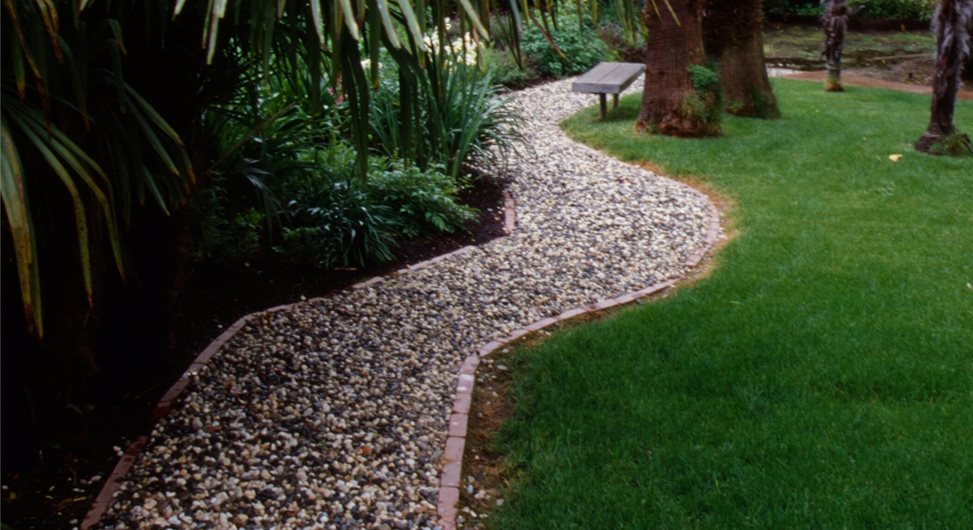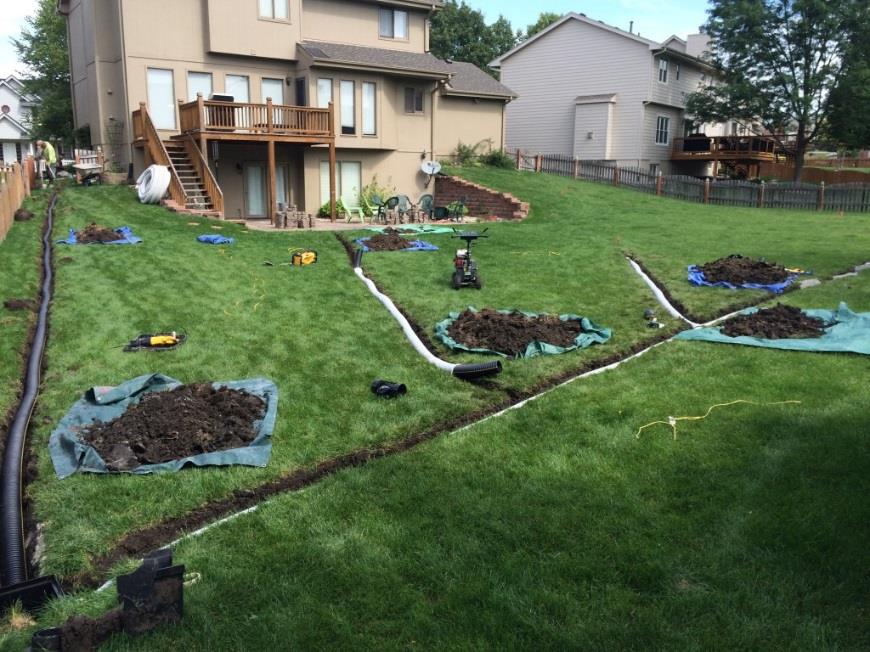Waterlogging can be one of the most frustrating issues for gardeners, especially when it prevents your plants from thriving or causes long-term damage to your lawn. When your garden becomes waterlogged, it’s not just unsightly—standing water can suffocate plant roots, promote the growth of harmful fungi, and lead to soil erosion. Fortunately, there are several effective drainage system for garden solutions available to prevent waterlogging and keep your garden healthy. In this guide, we’ll explore the top drainage solutions to tackle excess water and restore the beauty of your garden.
1. French Drains
A French drain is one of the most effective drainage systems for gardens with persistent waterlogging problems. It involves digging a trench, lining it with a geotextile fabric, and filling it with gravel. A perforated pipe is placed in the trench, allowing water to enter the pipe and flow away from the garden.
- Why It Works: The French drain allows water to collect in the perforated pipe and then be redirected to an area where it won’t cause damage, such as a soakaway or storm drain.
- Best For: Areas with poor drainage, clay soil, or places where surface water needs to be diverted.
- Benefits: Effective for large areas and versatile in handling both surface and groundwater issues.
2. Soakaways
A soakaway system is designed to collect excess water and let it percolate into the ground. It typically consists of a pit filled with gravel or large stones, which allows water to soak through the material and slowly disperse into the surrounding soil.
- Why It Works: Soakaways are perfect for gardens with permeable soil that can absorb water efficiently. The water has space to filter through the gravel and return to the groundwater table.
- Best For: Gardens with well-draining or sandy soil that can handle water infiltration.
- Benefits: Eco-friendly, low-maintenance, and effective in preventing surface water accumulation.
3. Trench Drains
For areas where water frequently pools, a trench drain can be an effective way to redirect water. It involves digging a narrow trench in the affected area and filling it with a gravel or drainage pipe system. The trench collects surface water and channels it away from the garden.
- Why It Works: Trench drains are especially useful for localized drainage issues, such as along garden paths, driveways, or near buildings, where water tends to collect.
- Best For: Areas that are prone to surface water runoff or flood-prone spots.
- Benefits: Easy to install in small areas and can be customized to direct water to specific areas.
4. Swales (Shallow Ditches)
Swales are shallow, vegetated ditches or depressions designed to direct and manage water flow. They can be planted with grass or other vegetation to slow down the flow of water, allowing it to be absorbed into the ground rather than pooling on the surface.
- Why It Works: Swales are natural and eco-friendly solutions that use the landscape’s natural slope to direct water to areas where it can infiltrate.
- Best For: Sloped gardens or larger outdoor spaces where water needs to be diverted away from areas of the garden.
- Benefits: Low-cost, sustainable, and effective at preventing erosion while managing runoff.
5. Surface Drains
Surface drains are designed to collect and redirect water that accumulates on the surface of your garden. These drains are placed in low-lying areas where water tends to pool, usually leading it to a French drain or soakaway system.
- Why It Works: Surface drains act as catch basins, intercepting excess water before it causes flooding or damage to your plants and soil.
- Best For: Gardens with flat terrain or large open spaces where surface water pools.
- Benefits: Simple installation and excellent for dealing with heavy rainfall or runoff.
6. Dry Wells
Dry wells are similar to soakaways but are typically deeper and can handle larger volumes of water. They consist of a deep hole filled with gravel or other permeable material, allowing water to seep through the gravel and back into the ground.
- Why It Works: Dry wells collect excess water from downspouts, surface drains, or other sources and allow it to gradually filter into the ground.
- Best For: Large gardens or areas with high water volume, such as lawns near gutters or downspouts.
- Benefits: Effective at handling large amounts of water and reducing standing water in your garden.
7. Gutters and Downspout Systems
Sometimes waterlogging in a garden is caused by excessive water flowing off your roof and into the garden. Installing or improving a gutter and downspout system can help divert water away from your garden and into the drainage system.
- Why It Works: Gutters and downspouts collect rainwater from the roof and direct it into a drainage system like a French drain, trench drain, or soakaway, preventing water from accumulating near your garden.
- Best For: Homes with gardens near downspouts or areas where roof runoff is a major problem.
- Benefits: Simple and cost-effective way to prevent water from pooling around garden beds and lawns.

8. Permeable Paving
If you’re concerned about drainage around pathways, patios, or driveways, permeable paving is an excellent option. This paving allows water to seep through the surface and be absorbed by the underlying soil, preventing runoff and pooling.
- Why It Works: Permeable paving materials, such as porous concrete or gravel grids, allow rainwater to pass through rather than running off the surface.
- Best For: Hard surfaces like patios, driveways, or garden paths where water often accumulates.
- Benefits: Reduces runoff, prevents puddles, and integrates seamlessly into your garden design.
9. Raised Garden Beds
If your garden is prone to waterlogging, raised garden beds can help by elevating the soil above the wet ground. This prevents plant roots from sitting in waterlogged soil and helps improve overall drainage.
- Why It Works: Raised beds provide better drainage, reduce soil compaction, and allow excess water to flow away from plant roots.
- Best For: Gardens with poorly draining soil or areas where standing water accumulates.
- Benefits: Easier to manage, especially for vegetables, flowers, or shrubs that require well-drained soil.
10. Hydroseeding for Improved Drainage
Hydroseeding involves spraying a mixture of seeds, mulch, and fertilizer over an area to promote quick, healthy growth. Some hydroseeding mixes include materials that help improve soil structure and drainage.
- Why It Works: Hydroseeding improves soil stability and encourages the establishment of plant roots, which can help manage water infiltration.
- Best For: Areas where waterlogging is causing erosion or where grass needs to be established quickly.
- Benefits: Helps with soil erosion, promotes healthy plant growth, and improves drainage over time.
Conclusion
Waterlogging doesn’t have to ruin your garden. With the right drainage system, you can prevent excess water from pooling and ensure your garden stays healthy and beautiful. From simple solutions like French drains and soakaways to more advanced techniques like swales and permeable paving, there are a variety of drainage options to suit your garden’s specific needs. By addressing drainage issues early, you’ll protect your plants, prevent erosion, and enjoy a lush garden that thrives no matter the weather.



